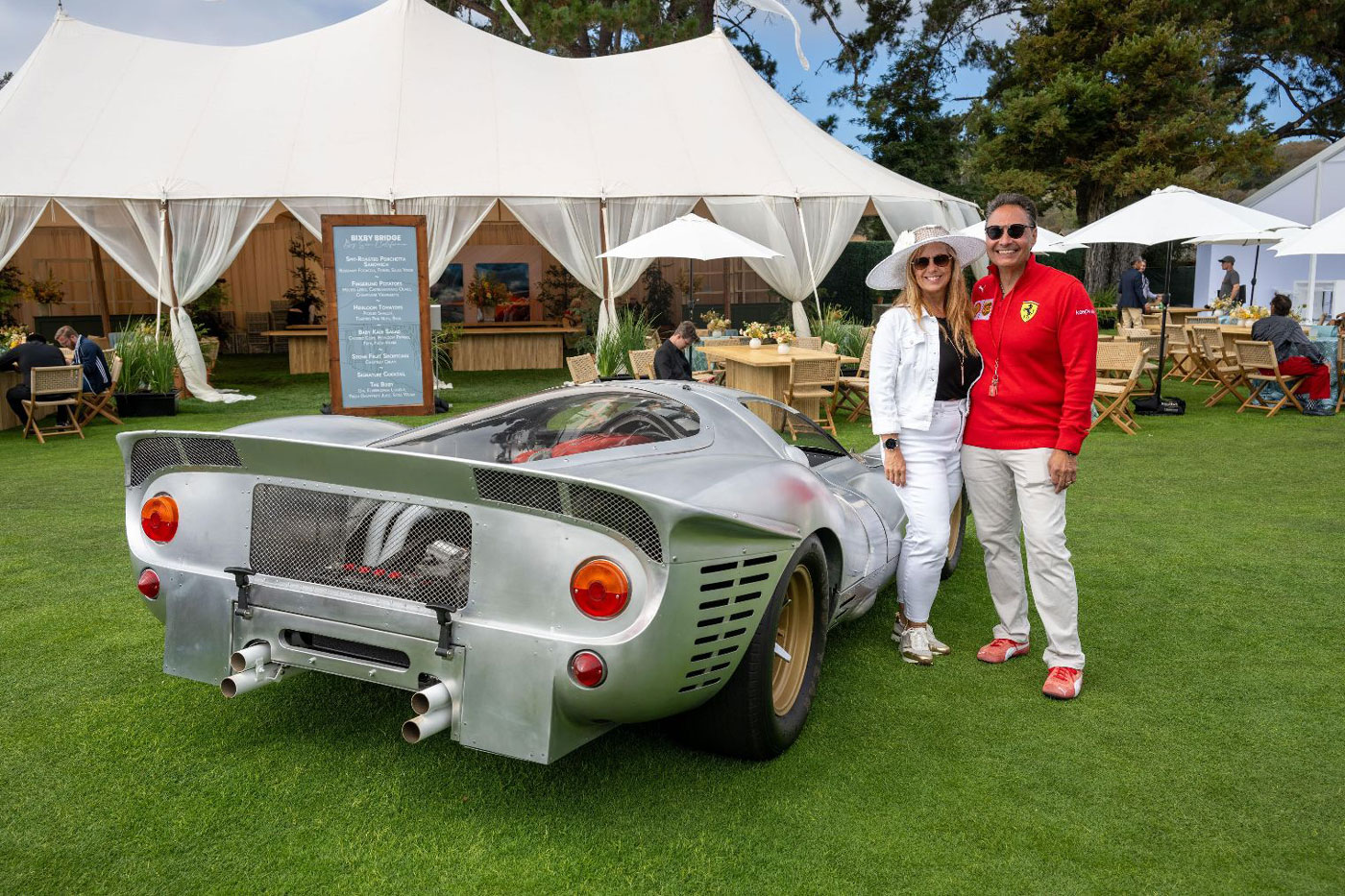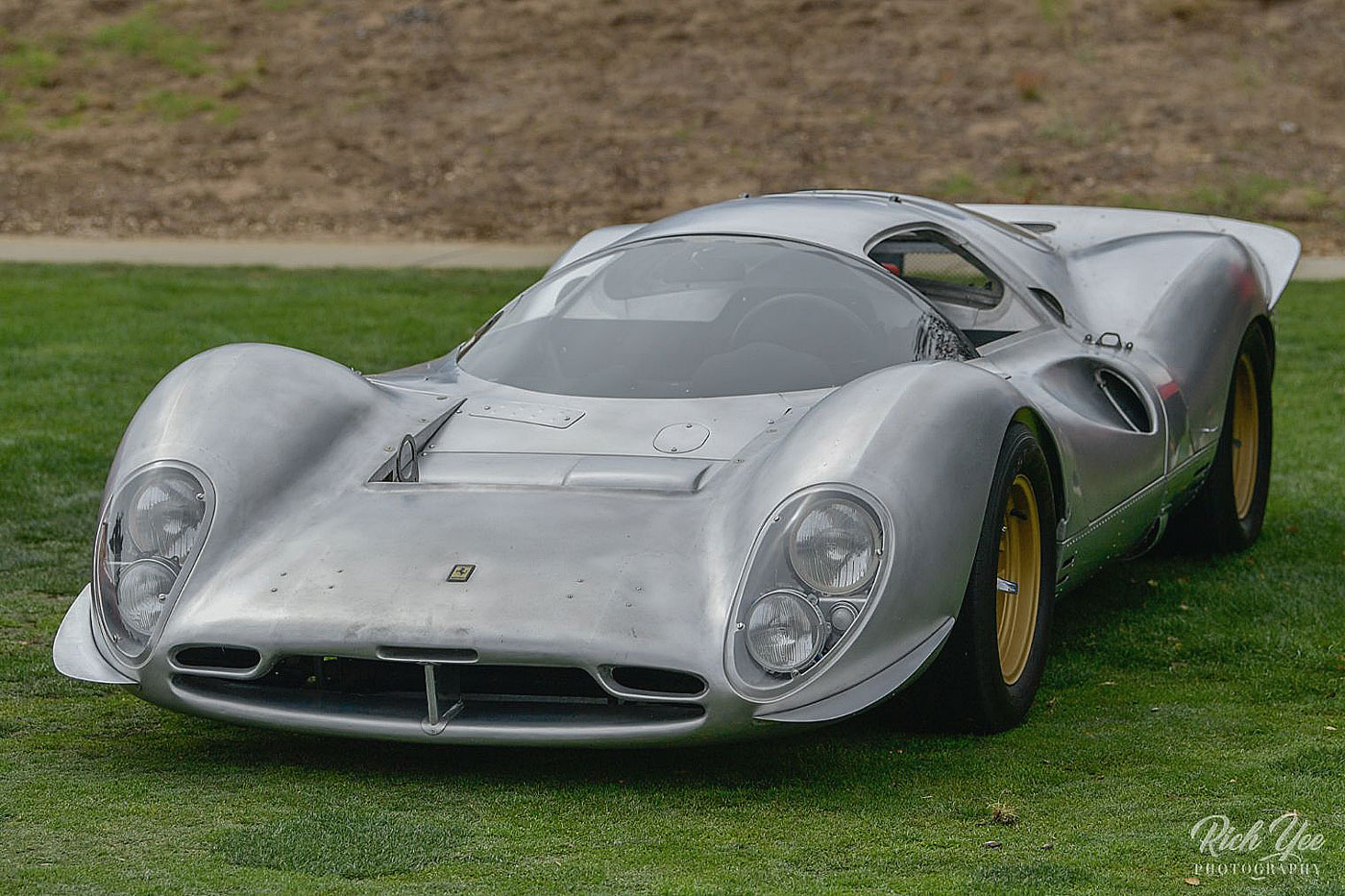By Brandes Elitch
Photos courtesy John Nino
“When it does not exist, design it,” Henry Royce
At Monterey Car Week you would rightfully expect to be surprised and delighted by some of the things you will see, both on the show field and in the streets. After all, between the three major shows (Quail Lodge, Pebble Beach, and the Concorso Italiano), not to mention the Historics at the Laguna Seca racetrack, there will be over a thousand show cars on display, many of them quite fantastic. This year was no exception, an embarrassment of riches, so to speak. It can be quite overwhelming. You have to pace yourself, and from time to time just have a sit down and catch your breath, because some of these experiences can take your breath away.
At the Quail Lodge show, one that took my breath away was certainly not something I was expecting. It was a “tribute car,” a 1967 Ferrari P3/412P recreation, built over a ten-year period by John Nino, with assistance from British Ferrari privateer and racing legend David Piper, who at 92 years of age is still a force in the Ferrari community. I was so struck by this masterpiece that I asked Mr. Nino if he would give me some background, and here are some of my notes from my interview with him.
John is no stranger to building cars. He has by his count modified or restored around forty of them, primarily muscle cars and street rods. At some point he got the idea of re-creating a Ford GT 40, but then he found out about the Ferrari 412P, and from that point on he was hooked. Only four were built, so if he wanted one, he would have to re-create it. He even picked a date to copy: April 25, 1967. He says that when viewing this for the first time, he saw it as the most beautiful vintage race car ever built, although of course the factory did not originally build it as a vintage race car. He chose to emulate chassis 0848.
The 412P was sold by the factory to private race teams. It differed from the 330P4 in that it had a carbureted two valve motor, and a different chassis with a shorter wheelbase. Two cars (0850 and 0854) were originally built as a 412P. Two others (0844 and 0848) were converted by the factory from P3s to 412. The motor was an alloy V12, placed in a mid-longitudinal position. It was a 3.989 litre with 11:1 compression ratio, putting out 420 bhp at 8000 rpm. The body was aluminum over a semi-monocoque frame. Top speed was around 190 mph.
The P4 debuted in December, 1966. The motor was based on the 3 litre Formula One motor. The P4 took first and second spots in the 1967 Daytona 24 Hours. The P4s also placed at LeMans that year, which enabled the Scuderia to win the World Sportscar Championship that year. As seems to always be the case, new FIA rule changes quickly followed, and the 412P did not meet those new rules, based on engine size and number of cars to be built for homologation standards.

John Nino and Aaron Chovanetz “Metal Shaper Extraordinaire”, planning the 412P body recreation – MC Auto Creations.
John Nino is (literally) a rocket scientist. He worked on the development and testing of the main engine for the Space Shuttle and other liquid fueled propulsion systems. He has 26 patents to his credit (for surgical instrumentation). Needless to say, he is a stickler for accuracy and precision fabrication. As John says, “Since P cars were hand built by the Ferrari factory race team, using parts from various road cars and race cars, parts are no longer obtainable, sixty years later.” John made a dimensionally accurate aluminum body and a chromoly chassis designed to match the factory chassis. Many parts were not available, such as the wheels, which he had to have made from scratch. John says that about 75% of the pieces he needed had to be fabricated. He is quick to credit the various fabricators who made the parts for his car, and this is what made the build possible, these talented and creative people who support the vintage car community. This includes Stone’s Metal Shop in Gardena, CA, MC Auto Creations, Red Car Restorations, Race Crafters Manufacturing, GTS Customs, and Race Concepts.
What made this work was his friendship and help from Ferrari legend David Piper. There is not enough space in this short column to give Piper his due: he competed in both Formula One and Formula Two in 1959 and 1960. Between 1962 and 1970 he was involved in sports car racing as a privateer, with sponsorship from Ferrari. He raced at Le Mans eight times. He raced for Scuderia Ferrari, Maranello Concessionaires, and Filipinetti. He owned six GTOs over the years, and raced all over the world. As he said, “Once they (GTO) became obsolete, nobody wanted them, and you could buy them for $5000 or so.” He even lived in Modena, so he could be near the factory. It is not an exaggeration to say he is a Living Legend, particularly among Ferrari people.
John visited Mr. Piper at his home in England, and explained what he had in mind. From time to time, Piper would ship various pieces made out of unobtanium to John. Each part would come with a lively story and racing history lesson.
Piper loved John’s idea of using a more modern 600 hp V12 from a 550 Maranello, and more recent Ferrari suspension parts and brakes. Over the years, Piper collected spare parts for his cars and even copied original body panels in fiberglass (to use in case of an on-track incident). Piper supplied a fiberglass front piece, doors, tail, 3 windshields, Perspex headlight covers, suspension parts, and even the side latch mechanisms for the tail section.

Brian Stone and Geoff Monise – Stone’s Metal Shop, accurately recreating 412P nose section in aluminum.
Some of the front suspension and steering was liberated from a wrecked Dino. The rear suspension includes some 330 and 512BB pieces. The wheels were 3D modeled to fit the factory spline drive hubs. This required CNC machining. John says he spent “the better part of a decade” collecting “every correct light, switch, gauge, and air vent, and every part has its own story.” Cooling tubes run through the chassis from the front radiator to the motor just as in the original 412P and P4.
I asked John if he knew what he was getting into when he started this, and if he ever felt like giving up. He did say that the project took on a life of its own, and all the trials and tribulations resulted in him meeting some incredible people who made it happen, and he is quick to give them credit. It helps to have an engineering background and training and project management skills.
Is he ready to take on another project? He replied that he is still interested in the Ford GT 40, but a Bizzarrini or Iso Grifo project is intriguing, and I think that this would be a walk in the park compared to what he did here. Who knows what he could do with that? He said that “patience and perseverance” are the keys to such an effort. There were many times when he was doubtful, but then parts or drawings would just show up and he would meet another talented artist who could help. Coincidence? I think not. Ten years of continuous and focused effort ultimately paid off.
I will close with another quote from Mr. Royce, along the lines of “whatever is rightly done is noble.”
This is certainly a noble effort. More photos below.

The Stone’s Metal Shop Team, From Left to Right – Matt Momary, Brad Wynne, Brian Stone and Geoff Monise.

Brian Stone – Stone’s Metal Shop – Installation of P4 Headlight Perspex from David Piper’s Collection.





















An incredible achievement in any measure.
Something I did not see in the text.
Who was responsible for the surface execution? That is the surface development of the body? The design recreation. How was that approached and executed?
As most racing Ferraris at that time were works of art this one as a recreation is also, from what I see in the images.
What a great article! The craftsmen involved in this project are just unbelievable. Thanks for posting this.
I hope they never paint this amazing design!
david piper is more than a prince of a fellow; it feels good just to be with ten feet of this wonderful sportsman.
Is Geoff Monise any relation to the “back in the day” Lotus racer Frank Monise?
Pete you must consider doing a piece on Mr Piper ! He gave up a leg for the love of racing. Most have no idea of his contributions.
Reply to Dick Ruzzin: Thanks for your kind words. Cast-off fiberglass body parts, a windscreen and headlight Perspex from “Pipe’s” collection were used as the pattern for the aluminum body recreation. Those parts combined with countless photos and measurements from Original 412P and P4 cars were used to create a dimensionally correct tribute. Salute! JN
Reply – to Anatoly Arutunoff .
This build wouldn’t have been possible without David Piper’s support and guidance. I will forever cherish our time spent together.
He’s indeed a Prince among men and I’m incredibly grateful for his help and friendship. ? JN
In my opinion; the 330 P4 was the most beautiful race car of all time. This recreation of the 412P continues the legacy.
From Tom Matano:
I have been a fan of your website for quite some time. I love Italian cars and owned a few in the past. 1967 Fiat 850 Spider, 1974 Fiat X1/9, 1976 and 1977 Lancia Montecarlo (Scorpion), 1965 Detomaso Vallelunga.
I admire great timeless designs like Tipo 33 Stradale, P3/P4, TZ-I, SZ-I, Canguro, Guilia GTV, Gulietta Sprint, GT junior Zagato and so on…
I just read Brandes’s P4 article. It was a great article and Brandes’ writing style at it’s best. He has a right blend of historical, technical knowledge and flare of great coffee table reading style. I did feel the excitement, enthusiasm, passion, respect and friendship among the people involved. Thank you for informative and enjoyable stories.
Always Inspired
Tom Matano